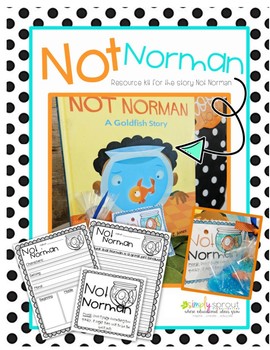Not Norman Reading Resource kit
Mrs Grauer
2.7k Followers
Grade Levels
PreK - 5th, Homeschool, Staff
Subjects
Resource Type
Standards
CCSSRL.3.2
CCSSRL.3.3
CCSSRL.3.5
CCSSRL.3.6
Formats Included
- PDF
Pages
7 pages
Mrs Grauer
2.7k Followers
What educators are saying
I used some of this resource with my kinders and they were able to fill in the sentences. I found them helpful to use.
Description
Not Norman is a great story to start the year off. It helps to teach character, setting, moral/lesson as well as sequencing of events. Read this story with your students and have them identify the story elements and write their own response to the story.
Norman is the best pet ( writing prompt)
I think that a ________ would be a better pet (writing prompt)
Kit includes:
Story elements sheet
Norman is the best pet ( writing prompt)
I think that a ________ would be a better pet (writing prompt)
Moral of the story tags
Slime recipe / activity
Visit us at simply sprout for more back to school inspiration.
www.simplysprouteducate.com
Created by Marcy Grauer
simplysprout@gmail.com
www.simplysprouteducate.com
We work hard to share our creative passion for education. Please do not resell or redistribute any items purchased. All items purchased are for single classroom use only, no redistributing or sharing electronically or in printed form. Please send your friends to our site if they are interested in the materials.
PLEASE NOTE...Files are for personal use only. You may not forward, share, sell, or distribute the file. It is for non-commercial use only. Simply Sprout retains all rights.
Norman is the best pet ( writing prompt)
I think that a ________ would be a better pet (writing prompt)
Kit includes:
Story elements sheet
Norman is the best pet ( writing prompt)
I think that a ________ would be a better pet (writing prompt)
Moral of the story tags
Slime recipe / activity
Visit us at simply sprout for more back to school inspiration.
www.simplysprouteducate.com
Created by Marcy Grauer
simplysprout@gmail.com
www.simplysprouteducate.com
We work hard to share our creative passion for education. Please do not resell or redistribute any items purchased. All items purchased are for single classroom use only, no redistributing or sharing electronically or in printed form. Please send your friends to our site if they are interested in the materials.
PLEASE NOTE...Files are for personal use only. You may not forward, share, sell, or distribute the file. It is for non-commercial use only. Simply Sprout retains all rights.
Total Pages
7 pages
Answer Key
N/A
Teaching Duration
N/A
Report this resource to TPT
Reported resources will be reviewed by our team. Report this resource to let us know if this resource violates TPT’s content guidelines.
Standards
to see state-specific standards (only available in the US).
CCSSRL.3.2
Recount stories, including fables, folktales, and myths from diverse cultures; determine the central message, lesson, or moral and explain how it is conveyed through key details in the text.
CCSSRL.3.3
Describe characters in a story (e.g., their traits, motivations, or feelings) and explain how their actions contribute to the sequence of events.
CCSSRL.3.5
Refer to parts of stories, dramas, and poems when writing or speaking about a text, using terms such as chapter, scene, and stanza; describe how each successive part builds on earlier sections.
CCSSRL.3.6
Distinguish their own point of view from that of the narrator or those of the characters.





